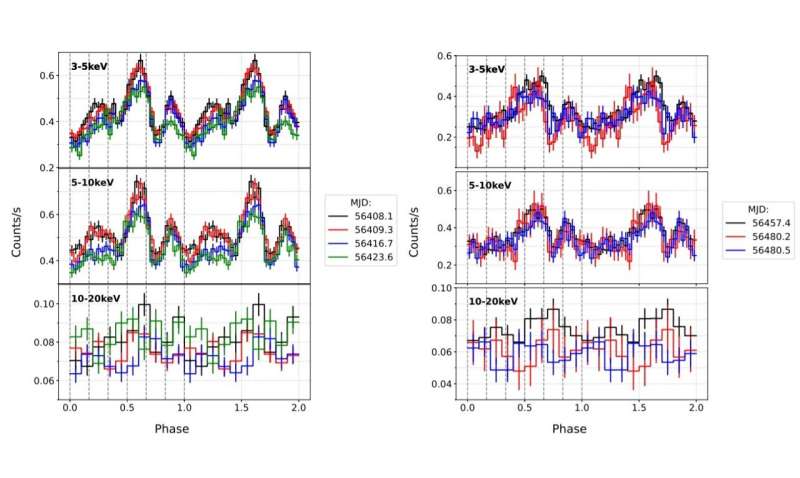
Using NASA's Nuclear Spectroscopic Telescope Array (NuSTAR), Russian astronomers have investigated the behavior of a magnetar known as SGR J1745–2900 after its outburst in April 2013. Results of the study, published June 9 on arXiv.org, could be essential to better understand the nature of this magnetar.
Magnetars are neutron stars with extremely strong magnetic fields, more than quadrillion times stronger than the magnetic field of our planet. Decay of magnetic fields in magnetars powers the emission of high-energy electromagnetic radiation, for instance, in the form of X-rays or radio waves.
SGR J1745–2900 is a magnetar in the vicinity of the supermassive black hole Sagittarius A* located in the center of our Milky Way galaxy. It was detected as an X-ray flare on April 24, 2013, during a regular monitoring of the galactic center with the Burst Alert Telescope (BAT) aboard NASA's Swift spacecraft.
Follow-up observations of SGR J1745–2900 have found that it showcases pulsations with a period about 3.76 seconds and a spin-down rate of 6.5 picoseconds/second. The source has a magnetic field of some 160 trillion G, spin-down power of approximately 5.0 decillion erg/s, and characteristic age of about 9,000 years. One of the instruments that started to observe SGR J1745–2900 shortly after its detection was NuSTAR; now, a group of astronomers led by Ekaterina Kuznetsova of the Space Research Institute in Moscow, Russia, presents the results of this monitoring campaign.
"In this paper we present the results of our timing analysis (the pulse profiles and the pulsed fraction) and phase-resolved spectroscopy for the magnetar SGR J1745–2900 based on data from the NuSTAR observatory for several months after its X-ray outburst occurred in April 2013," the researchers wrote in the paper.
The NuSTAR data allowed the team to identify significant changes in the apparent sizes of the region in SGR J1745–2900 responsible for the thermal emission correlating with the pulse profile in the 3–5 keV energy band. It was found that the temperature of this region remains fairly stable on pulse, while is generally decreasing with decreasing intensity of the source.
Furthermore, the study found no significant changes in the total flux of the power-law component with a fixed photon index of 1.11. However, the astronomers noted that the available data does not allow them to confirm that the non-thermal component indeed does not pulsate.
The researchers estimate that the pulsed fraction for two energy bands, 3–5 and 5–10 keV, is at a level of 40-50 percent. They also found evidence for a significant increase in the pulsed fraction with decreasing flux from SGR J1745–2900.
"Such high pulsed fractions may point to an asymmetric arrangement of two opposite thermal emission regions (Beloborodov, 2002). However, using the 2016 data, when the magnetar pulse profile underwent significant changes, Hu et al. (2019) suggested that two approximately symmetric opposite emission regions, whose intensities differ by more than a factor of about 3, are observed for SGR J1745–2900," the authors of the paper concluded.
Explore further
© 2021 Science X Network
Citation: Study investigates the behavior of magnetar SGR J1745–2900 (2021, June 16) retrieved 17 June 2021 from https://ift.tt/3iK2Qcz
This document is subject to copyright. Apart from any fair dealing for the purpose of private study or research, no part may be reproduced without the written permission. The content is provided for information purposes only.
"behavior" - Google News
June 16, 2021 at 10:05PM
https://ift.tt/3iK2Qcz
Study investigates the behavior of magnetar SGR J1745–2900 - Phys.org
"behavior" - Google News
https://ift.tt/2We9Kdi
Bagikan Berita Ini














0 Response to "Study investigates the behavior of magnetar SGR J1745–2900 - Phys.org"
Post a Comment